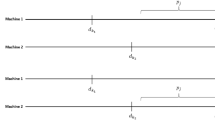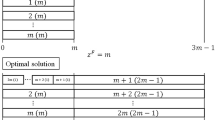Abstract
The basic scheduling problem we are dealing with in this paper is the following one. A set of jobs has to be scheduled on a set of parallel uniform machines. Each machine can handle at most one job at a time. Each job becomes available for processing at its release date. All jobs have the same execution requirement and arbitrary due dates. Each machine has a known speed. The processing of any job may be interrupted arbitrarily often and resumed later on any machine. The goal is to find a schedule that minimizes the sum of tardiness, i.e., we consider problem Q∣r j ,p j =p, pmtn∣∑T j whose complexity status was open. Recently, Tian et al. (J. Sched. 9:343–364, 2006) proposed a polynomial algorithm for problem 1∣r j ,p j =p, pmtn∣∑T j . We show that both the problem P∣ pmtn∣∑T j of minimizing total tardiness on a set of parallel machines with allowed preemptions and the problem P∣r j ,p j =p, pmtn∣∑T j of minimizing total tardiness on a set of parallel machines with release dates, equal processing times and allowed preemptions are NP-hard. Moreover, we give a polynomial algorithm for the case of uniform machines without release dates, i.e., for problem Q∣p j =p, pmtn∣∑T j .
Similar content being viewed by others
References
Baptiste, Ph., Brucker, P., Chrobak, M., Dürr, C., Kravchenko, S. A., & Sourd, F. (2007). The complexity of mean flow time scheduling problems with release times. Journal of Scheduling, 10, 139–146.
Du, J., & Leung, J. Y.-T. (1990). Minimizing total tardiness on one machine is NP-hard. Mathematics of Operations Research, 15, 483–495.
Kravchenko, S. A., & Werner, F. (2009a). Minimizing a separable convex function on parallel machines with preemptions. Fakultät für Mathematik, Otto-von-Guericke Universität Magdeburg. Preprint 22/09, 20 p.
Kravchenko, S. A., & Werner, F. (2009b). On a parallel machine scheduling problem with equal processing times. Discrete Applied Mathematics, 157, 848–852.
Labetoulle, J., Lawler, E. L., Lenstra, J. K., & Rinnooy Kan, A.H.G. (1984). Preemptive scheduling of uniform machines subject to release dates. In H. R. Pulleyblank (Ed.), Progress in combinatorial optimization (pp. 245–261). New York: Academic Press.
Lawler, E. L. (1976). Combinatorial optimization: networks and matroids. New York: Holt, Rinehart and Winston.
Lawler, E. L. (1977). A ‘pseudopolynomial’ algorithm for sequencing jobs to minimize total tardiness. Annuals of Discrete Mathematics, 1, 331–342.
Lawler, E. L. (1983). Recent results in the theory of machine scheduling. In A. Bachem, M. Grötschel, & B. Korte (Eds.), Mathematical programming: the state of the art (pp. 202–234). Berlin: Springer.
Tian, Z., Ng, C. T., & Cheng, T. C. E. (2006). An O(n 2) algorithm for scheduling equal-length preemptive jobs on a single machine to minimize total tardiness. Journal of Scheduling, 9, 343–364.
Author information
Authors and Affiliations
Corresponding author
Rights and permissions
About this article
Cite this article
Kravchenko, S.A., Werner, F. Minimizing total tardiness on parallel machines with preemptions. J Sched 15, 193–200 (2012). https://doi.org/10.1007/s10951-010-0198-5
Published:
Issue Date:
DOI: https://doi.org/10.1007/s10951-010-0198-5




